Preface 2023
Preface – magazine 2023 A contemporary magazine feeds upon dynamism and vigour. It instantly perceives the inputs deriving from the readers and evolves, offering its best at...
Preface – magazine 2023 A contemporary magazine feeds upon dynamism and vigour. It instantly perceives the inputs deriving from the readers and evolves, offering its best at...
To speak of the wicker bottle, an object of common use, made with a glass of no value and covered with marsh grass, may seem a forced unearthing of micro-history, a folklore and...
Pinocchio was born in post-unification Florence. Actually, more plausibly, he was born in the Florentine countryside, hardly disturbed by the great changes of the late nineteenth...
Dear Readers, You will surely know that to embark on this magazine means to venture the thousands of meanings that food and its preparation had and continue to have in the history...
La terra brucia – stiamo sventrando le sue radici. La terra la stiamo distruggendo – noi – i suoi nemici. La terra – quella che abbiamo avuto in dono...
An essential application for sharing photos and/or videos, Instagram has become, within a decade, the fastest growing social media. According to the latest estimates, we...
Time machine does not always proceed backwards towards extraordinary and memorable days. Actually, 1 December 1928 appears as an ordinary working day. Yet, behind the crumpled and...
Foreword by Giovanna Frosini Materials, shapes, colours, flavours: the language of food transforms all this into words, it coats with sounds a fundamental and daily experience,...
There is the scent of freshly cut grass in the air, the grass of the magnificent gardens of Villa Bardini, on Costa S. Giorgio, overlooking Florence. The Villa takes its name from...
Food in the cinematic imagination From its origins, cinema has described the relationship between man and money, investing it with cultural connotations that range from ethnic to...
Officina Profumo-Farmaceutica di Santa Maria Novella in Florence is one of the oldest pharmacies in the world, founded by the Dominican friars in 1221 and open to the public since...
To speak of the wicker bottle, an object of common use, made with a glass of no value and covered with marsh grass, may seem a forced unearthing of micro-history, a folklore and nostalgic rediscovery of now lost traditions, traces of an artisan past connected to the agricultural economy. On the contrary, the history of this glass container enfolds the centuries, thanks to the skill of both the fiascai masters (flask blowers) and their blowpipes, and to the satellite activities of those women who took care of the dressing of the finished object, to preserve it from shocks and the excess of light.
It was precisely the wicker bottle, intended mainly to contain wine and oil that secured a close relationship between the two main products of the Tuscan economy until it became a tangible symbol of the link between the agricultural resource and the manufacturing ability.In recent years, scholars have commenced a systematic reconstruction of the evolution of the wicker bottle, described in the Novo Vocabolario of the Italian language by the Crusca (1887-1897) as “A glass vase, round and thick […], without foot; with a covering or […] covered with straws 1 , which surround the body, and support it at the base”.
Experts have analysed excavation fragments, and have started a cataloguing of objects preserved in private collections, which sometimes have become almost real museums. They have analysed pictorial images, especially of the Tuscan area, that accurately attest formal variations and the practical use of such container. In parallel, the archival sources report precise information about the legislative provisions regarding wine tax and announcements issued to avoid fraud on the precious wine content, considered a nutritious food as well as an essential component for medicaments prepared in apothecaries.
The result is an intriguing investigation, conducted on several aspects, that is not always simple and is occasionally hampered by those who still consider legitimate the division between major arts and minor arts. Connections on the life-long habits through the centuries, trades, practicability, and economic network have emerged, as well as the constant expertise of the glass masters on whom the perfection of the container, used for bottling, and its transport up to everyone’s tables depended.
The exact date of the spread of wicker bottles made of glass is still uncertain. In the first half of the 14th century, the Guild of Doctors and Apothecaries replaced the tinned metal container with wicker bottles. The legislative provision intended to put an end to the constant fraud on the composition of the metal alloy, to which too much lead was added, a substance harmful to people’s health and a cause of organic alteration of the liquid contained. Moreover, as people had known since ancient times, the glass did not modify the consistency and flavour of the liquid. It did not transmit odours or flavours, as was the case with the porous walls of terracotta containers.
The archival information records the presence of the glass wicker bottle at the beginning of the fifteenth century, while few fragments of convex bases, belonging to apodous receptacles recovered in settings under archaeological investigation, emerged in layers dating from the beginning of the subsequent century. An exception that anticipates the diffusion of glass wicker bottles is offered by two Novellas of the Decameron (VIII, of the IX day; II, of the VI day), compiled by Giovanni Boccaccio between 1348 and 1353, which refer to a glass container, suitable to keep wine.
The eighth novella tells the story of Ciacco, “an extremely gluttonous man”, who was deceived by such Biondello on the expectation of a lavish lunch, which, instead, turned out to be quite frugal. Ciacco gave back to Biondello the insult he had to experience, inviting him to go to a notoriously choleric character. Biondello had to ask him to fill an empty flask with excellent “vermilion wine”. The reaction was bitter and Biondello had to leave with the empty wicker bottle. The other novella, the II of the sixth day, tells of the baker Cisti who refused to deliver his excellent wine to a boy who, to keep a part of that delicacy to himself, had provided himself with a “great flask”, possibly of almost five litres. Once they clarified the fraudulent misunderstanding, the man delivered the wine in a wicker bottle of the right size.
Beyond the witticism of these stories, the two novellas offer a timely mention to the glass container, made of various sizes and capacities. However, no mention is made of the straw. It was the Tuscan kilns, or more precisely the ones in the Valdelsa territory, that produced wicker bottles and distributed them in the large centres of demographic growth, such as Florence. Here glasshouses were set up, and still today, we recognize their protagonists and events, their wide success and remarkable “traffic” (bustle) of clients.
To confirm that they already were making wicker bottles during the fourteenth century, some documents of the first half of that century show a clear distinction between two terms. The bicchieraio, who was the glassmaker who made glassworks for everyday use, such as glasses, ampoules, bottles and oil lamps, and who dealt with the direct sale of the finished products. Instead, the fiascaio was a master specialized in the realization of wicker bottle containers. In fact, the latter required specific skills and intuitive ability in calculating; expertise during the phase of the manual blowing (free blowing or mouth blowing), and in balancing the thickness of the central wall and of the neck, to avoid thinness or uneven thickness, which could cause cracks with the inevitable dispersion of the precious content. However, it is still not entirely clear whether the task of covering the flasks, with the marsh grass called “sala” or “stiancia“, belonged to the fiascaio or if the profession of “covering with (straw) garments” was autonomous, entrusted to external workers, even if executed inside the workshop.
A subsequent inventory, drawn up in 1435, by Nicholaio di Ghino, one of the most famous glass-makers in Florence and owner of a well-established furnace, declared that he possessed “4000 pounds of flasks clothed with salicornia“, as well as a large number of flasks “clothed (packed with straw) and naked”.
The news that they already produced glass bottles in the first half of the fourteenth century is confirmed by a contemporary pictorial proof. The painter Tomaso da Modena, in a fresco depicting Saint Jerome sitting on a bench in his study and reading ancient texts, illustrates a globular flask lined with horizontally arranged cords that just left the mouth of the bottle free. The container hangs on a nail driven into the wall, according to a very practical habit, supported by lateral spiral-braided little ropes (fig. 1).
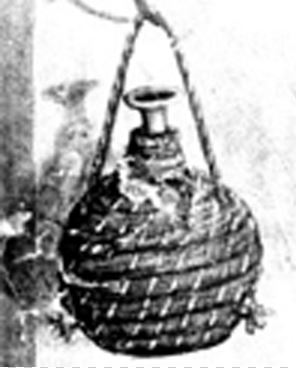
Being the study of a monk, it is likely that the wicker bottle contained liqueur wine to alleviate him from harsh winters. Another hypothesis, more in keeping with the activity carried out by the religious man intent in the transcription of classical or sacred texts, is that the wicker bottle retained ink for writing, subsequently transferred into special vials with inkwell function. The fact that the fresco is the work of an Emilian painter, far from the Tuscan figurative traditions, is indeed a precious testimony of how that specific container spread outside the regional boundaries. This confirmed also the presence, not periodic or occasional, of glassmakers from Valdelsa who operated abroad.
It is no coincidence that in Modena, the city of origin of the painter Tomaso, a furnace run by Florentine glassmakers was active since the third decade of the fourteenth century. Furthermore, we now know that emigrated glassmakers used to keep their operating tradition alive and graft extraneous objects inside the foreign reality in which they operated. This way they contributed to the diffusion of techniques and typologies, adapted to different realities and agricultural and domestic practices.On the other hand, many documents of the fifteenth century provide detailed information on the different capacity of the glass bottles in current use. There was a large bottle, called di quarto (a quarter), of 5.7 litres, equivalent to a small current demijohn; a medium one, called di mezzo quarto (half a quarter), of 2.8 litres, and finally a smaller one, called di metadella (half of), of 1.4 litres. This evidence suggests that the trade of wine and oil, but above all wine, from the countryside to the city was flourishing and aimed at both private buyers and retail traders.
The pictorial evidence, among many examples, illustrates perfectly the shape and function of the wicker bottle. People used the larger containers for food provisions. A 1483 painting by Sandro Botticelli offers an eminent example of extreme descriptive punctuality. It illustrates a scene from the Banquet for Nastagio degli Onesti. Leaning on a trunk, both for protection and to take advantage of the shadow, two large wicker bottles are used to transfer the wine into glass or metal ampoules, which then the cupbearers proceeded to pour into the commensals’ glasses (fig. 2).
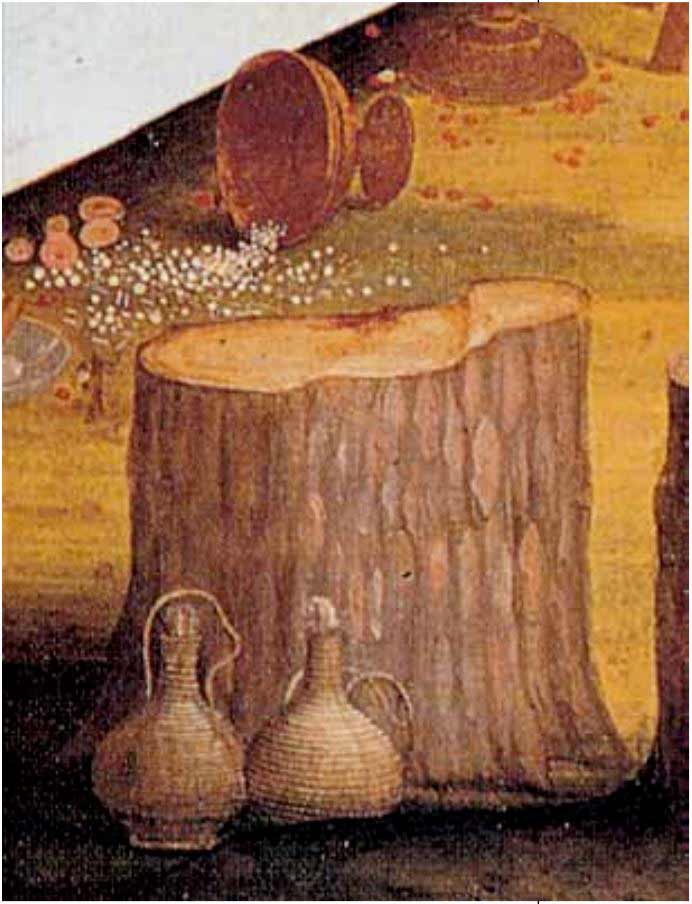
Bottles equally capacious, but more agile to handle, are those depicted in a lunette of the Florentine Oratorio di Buonomini di San Martino. Here goodwill men are distributing food to people in need (fig. 3) assisted by the secular confraternity.
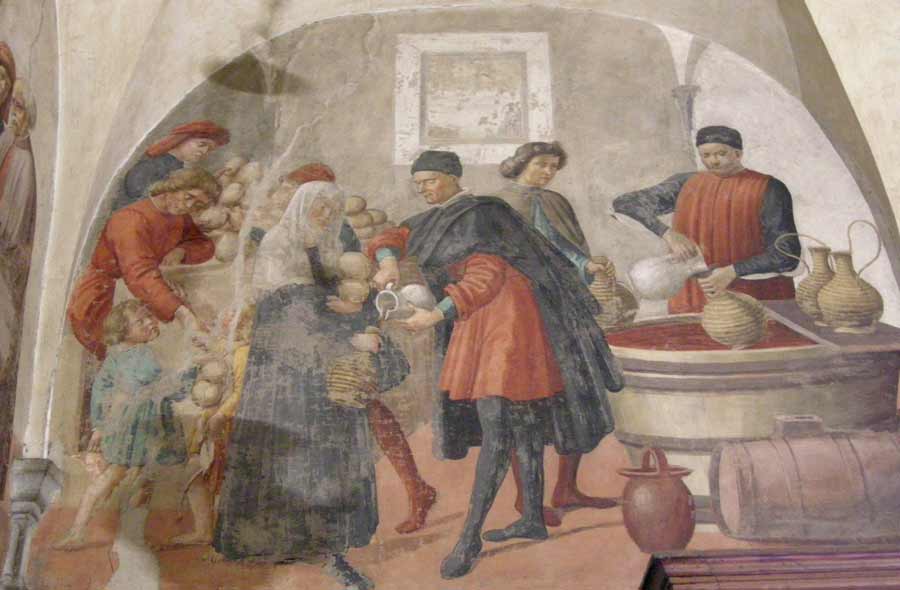
The painting, linked to the ambit of the Ghirlandaio family workshop, and dating back to around 1480, confirms that wine, like bread, was considered a nutritious and stimulating food. Without overlooking the clear reference to bread and wine as parts of the Eucharistic ceremony.
XV century paintings depicted small-sized bottles, equal to 1.4 litres, employed to contain liqueur wine, both alcoholic and sweet. Habitually, after pouring it into bottles or glasses, people offered such wine to mothers who had just given birth so to regain the energy lost during the childbirth.
Archive documents report how constant frauds to evade taxes on wine – transported and sold in wicker bottles – were. Decrees and laws attempted to remedy to such frauds, often with little efficacy. An announcement of 1481 established a limit to the sale of the wine in wicker bottles because the lightness and the low cost of such containers simplified the direct relation between producer and consumer.
This allowed evading both the tax on the transport of the wine, weighed entirely on draymen, and the fee for the retail sale charged to the hosts. A century later, in 1574, to avoid the constant fraud on the quantity of wine, a notice established that the capacity of the wicker bottles was set in “half a quarter”, equal to 2.8 litres. However, the fraud continued. It was enough to produce containers with thicker or slightly larger glass than the size allowed by law. In that case, the wine tax remained unchanged, but the quantity of liquid transported was greater, benefiting retail sales. A few years later, in 1618, they established a lead punching, which consisted of a “lead bullet, pierced in the middle”, called “public sign”, applied directly on the wicker bottle covering, to homologate its capacity. Even this solution was not sufficient to avoid fraud, although it established that anyone who contravened the legislative provision would be punished with a high fine, equal to “two crowns for each flask”.
They soon devised a way to circumvent this new regulation. It was enough to place bottles of a different capacity than the prefixed one or new wicker bottles within already approved straw garments, bearing the mark of the paid tax, to elude the duty. In 1626, it was decided that the stamp should be affixed directly to the glass. This container, which until then had not undergone changes in the shape and way of arranging the straw, changed its appearance: the neck became longer and part of the shoulder remained uncovered, freed from the covering in Salicornia straws.
One of the most accurate images, confirmed to a sure dating of the pictorial work that marks the temporal break with legislative innovation, is a painting by Jacopo Chimenti, called Empoli. It portrays a Pantry with crockery, eggs, sausages and fish (1625). Here we see a wicker bottle arrayed in straws up to the neck, identical to those made in previous centuries and not adequate to the 1626 legislation (fig. 4).
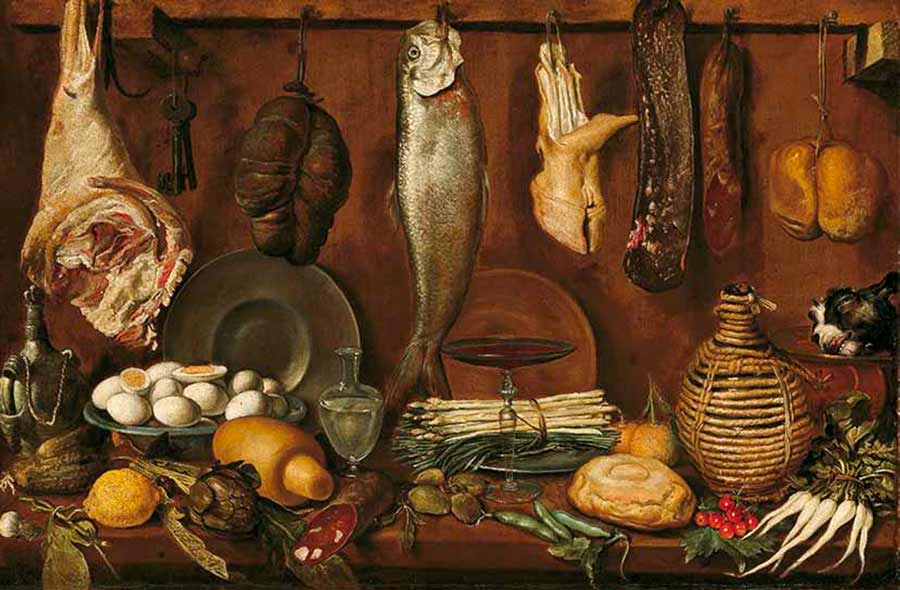
The wicker bottle was a common object and widely used in apothecaries and chemistries for its capacity and low cost. The Officina Profumo-Farmaceutica di Santa Maria Novella in Firenze preserves some rare specimens, datable to the end of the 16th century. In all likelihood, those “bowls” had been made in a furnace, currently unidentified but located in Pontorme, a town placed between Empoli and Montelupo Fiorentino. Precious majolica vases also arrived from this area into the Dominican pharmacy to preserve the medicines “displayed” on racks and shelves (fig. 5).
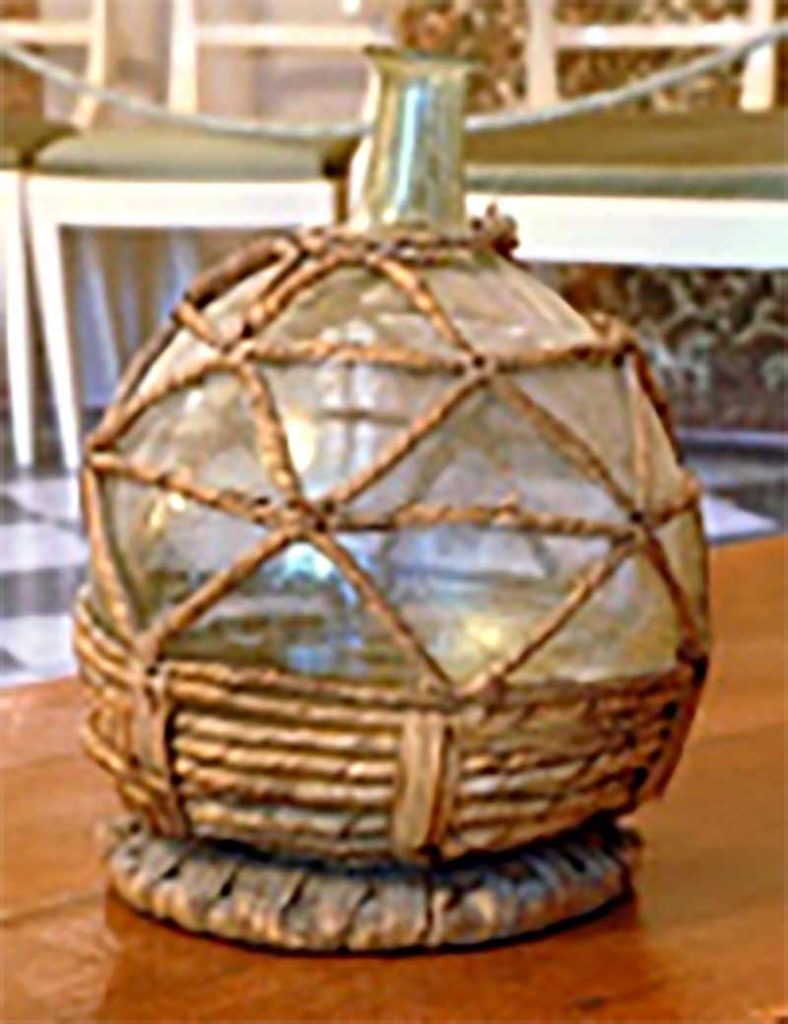
The apothecary wicker bottles, identical in shape to the wine ones, differed by the use of lighter green glass and by the arrangement of the straw woven in overlapping lozenges, in two or three horizontal rows. That solution allowed an easy checking of the liquid content, the level, the consistency, the colour and any alterations of the substance, usually oily or liquid, derived from distillation. A chronicle written in 1677 by Francesco Bocchi (1548-1618), Le bellezze della città di Fiorenza (The beauties of the city of Florence) tells about the Officina apothecary here nominated with the grand duchy title of Real Fonderia (Royal Foundry). It also specified that “in another room […] with shelves adorned are […] large numbers of distilled water bottles”, proving that those laboratory procedures had remained unchanged over the centuries.
[1] These straws were called “sala” or “stiancia”, a marsh grass (Typha latifolia) with long leaves that, after being dried in the sun and bleached with sulfur, were used for covering the flasks. It grew spontaneously near rivers or swamps. Leaves were kept moist during the coating so that losing their sharpness they become more manageable. In Tuscany, until the 1930s, this grass was collected near the marshes of Bientina, Fucecchio and along the Arno River.